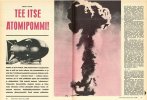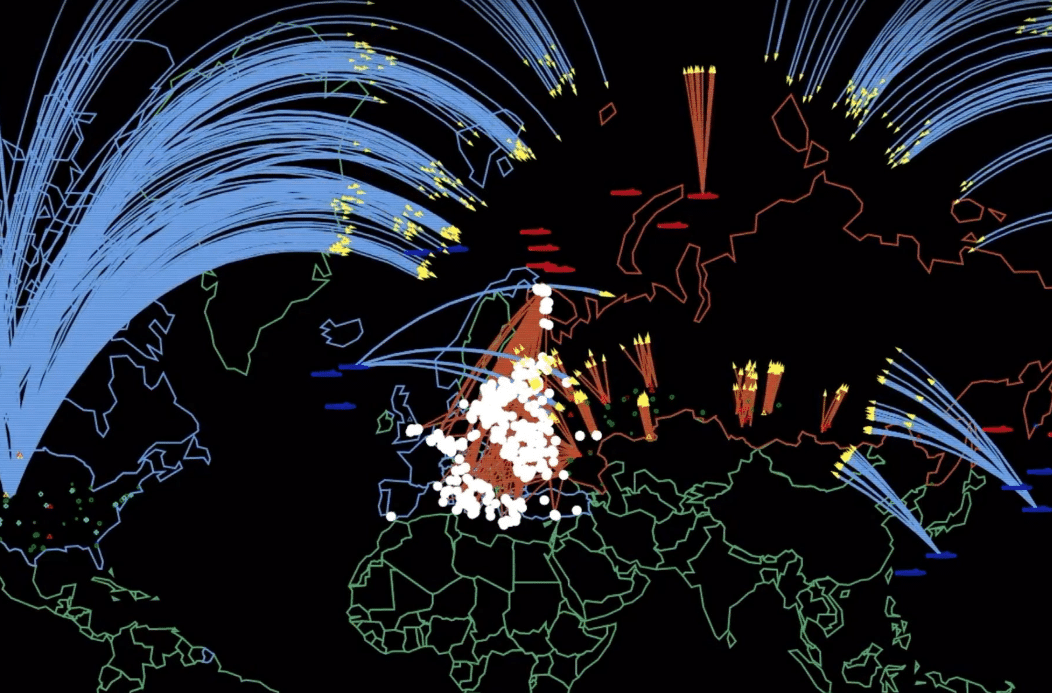Putin's Iskander Missiles Are Battle-Tested—and Can Carry Nuclear Warheads
By
William M. Arkin On 4/18/22 at 5:00 AM EDT
U.S. intelligence is watching closely for signs that the Russian armed forces are preparing for any kind of nuclear strike, American military and intelligence sources tell
Newsweek.
Ever since Russian President
Vladimir Putin threatened the United States and
NATO not to intervene, saying that if they did, there would be "consequences that you have never encountered in your history," the intelligence agencies have been fixated on Russia's nuclear arsenal.
"Desperation is the key to understanding what's going on here," a senior official at the Defense Intelligence Agency tells
Newsweek. "Everyone is fixated on Mariupol, but elsewhere on the battlefield, Russia is making little to no progress. Meanwhile, there is an escalation from our side, both in the increasing unity of Europe—including the Scandinavians—and in the billions worth of arms being supplied, including for the first time, offensive arms."
The Biden administration announced last week that another $800 million worth of arms were being sent to Ukraine, including artillery guns, the first such weapons being supplied for the war.
The U.S. is "very concerned" about the possibility of Russia using nuclear weapons in the Ukraine conflict,
CIA Director William Burns said Thursday. "Given the potential desperation of President Putin and the Russian leadership, given the setbacks that they've faced so far, militarily, none of us can take lightly the threat posed by a potential resort to tactical nuclear weapons or low-yield nuclear weapons," he said.
Russia has stated that if Sweden and Finland join NATO, it would move nuclear weapons closer to the two countries. "There can be no more talk of any nuclear–free status for the Baltic [region]," said Dmitry Medvedev, deputy chairman of Russia's Security Council. Kremlin spokesman Dmitry Peskov added that Putin had already ordered the military to boost its forces opposite Europe.
"If Ukraine continues to provoke attacks on Russian cities, Russia will be forced to declare war," Peskov said, hinting something more massive than the "special military operation" declared on February 24.
Moscow says that a handful of attacks that have taken place on Russian soil were perpetrated by Ukraine, though Kyiv has not confirmed this. Russia reacted to the sinking of its Black Sea Fleet flagship
Moskva by attacking targets beyond the battlefield and threatening an escalation.
Intelligence and military observers say Russia hasn't made any direct nuclear moves so far, but they are closely watching the units with nuclear potential. That includes Tu-160 Blackjack and Tu-95 Bear bombers that have already been used to attack Ukrainian targets, and Iskander-M (NATO designation SS-26 Stone) short-range ballistic missiles, which have been extensively used.
According to Hans Kristensen of the Federation of American Scientists, one of the world's leading experts on nuclear arsenals and deployments, Russia possesses 1,000-2,000 non-strategic nuclear warheads, the majority of which are air-delivered and navy weapons. Kristensen estimates that there are about 100 nuclear warheads allocated to army units, a handful for legacy nuclear-capable artillery guns with the majority of the rest assigned to Iskander brigades (there are 12 brigades, three of which are deployed to Belarus).
Kristensen is closely monitoring current nuclear developments in Russia, though he warns of the dangers of overstating the threat.
"Monitoring and reporting on nuclear developments is a dilemma because it can cause panic, and so far the U.S. government has rightly decided to keep a low profile," he says. "But it is probably the most important thing to watch because of the significant humanitarian and military risks associated with nuclear use."
Kristensen points out that Russian statements regarding escalation and the potential for nuclear weapons closely mirror the exact language contained in formal Kremlin documents.
On June 2, 2020, for example, Putin signed "Foundations of the State Nuclear Deterrence Policy of the Russian Federation." The policy stated: "The Russian Federation reserves the right to use nuclear weapons in response to the use of nuclear weapons and other types of weapons of mass destruction against it and/or its allies, and in the event of aggression against the Russian Federation using conventional weapons which threatens the existence of the state itself."
According to Kristensen, "the crippling sanctions could potentially cause Putin to conclude that the future of Russia is, if not at risk, then certainly threatened at a much more fundamental level." The Russian president has said as much, calling sanctions "akin to declaring war."
A senior U.S. Air Force officer working on nuclear weapons tells
Newsweek that the only weapon the intelligence community takes seriously as a threat in the Ukraine war is the Iskander missile. Cruise missiles shot into Ukraine are vulnerable to being shot down, and artillery is too short range and unreliable, the source says. "Only the Iskander has assured penetration, and it has performed surprisingly well."
The 310 mile range Iskander missile was introduced into Russian ground forces in late 2010, beginning the process of replacing the older and shorter-range Tochka-U (NATO SS-21 Scarab). In November 2019, chief of the Ground Forces Colonel General Oleg Salyukov said the Iskander deployment was completed.
The Iskander has several different types of warheads, a unitary explosive conventional warhead, a cluster munitions warhead, a fuel-air explosive warhead, an earth penetrator, a nuclear warhead, and a conventional electromagnetic pulse (radio frequency) warhead.
The missile is designed to maneuver in flight and is equipped with penetration aids that are intended to confuse surface-to-air missiles and ballistic missile defenses. "It is likely to be able to accurately target and destroy what it is being fired at," Timothy Wright, a research analyst with the London-based International Institute for Strategic Studies said.
Three brigades, or a total of 36 Iskander launchers (two missiles each plus two resupply missiles per launcher) were deployed to Belarus as part of the buildup to war in Ukraine. Two additional brigades (12 launchers) were also assigned to Russia's Southern Military District and moved forward in the area of Belgorod near the Russian border; and to the area of Krasnodar, south of Ukraine. Iskander missiles—both the standard high-explosive ballistic missile and a cruise missile variant—were extensively used at the beginning of the Ukraine war, hitting airfields, command centers, and headquarters. By the end of the first 96 hours, some 100 Iskanders had been fired, according to Ukraine's General Staff.
On March 10, the Ukrainian military reported that it has destroyed Iskander launchers in the Chernihiv Oblast, north of Kyiv, suggesting that missiles had moved south from Belarus. The missiles continued to be fired. By the end of March, some 200 Iskanders had been fired. On March 30, three specially configured Russian AN-124 transport planes flew into Belarus, delivering new missiles. An earlier resupply by rail is also thought to have taken place a week earlier. On April 2, it was reported that Russia was withdrawing Iskander missile launchers from Ukraine and around the border.
But after April 2nd, the number of Iskander firings almost halted. Some U.S. observers took that to mean that Russia was giving the launchers a rest, that the missile brigades were pulling back with the rest of the Belarus-based forces. Others suggest that the absence of many launches since then indicates their possible marshalling for an escalation in the future.
One potential for escalation, the DIA official says, is the use of an Iskander missile with a non-nuclear radio-frequency warhead able to knock out communications and modern electronics in a broad area, say in the entire capital of Kyiv. Any nuclear weapon detonated high in the altitude generates an electromagnetic pulse. A non-nuclear electromagnetic pulse is more akin to a high-powered microwave. A specialized Iskander radio frequency warhead is estimated to be able to achieve a radius of some 10 kilometers from the detonation point.
If Russia decided to escalate—to send a signal to the west and the United States, threatening their assistance to Ukraine—it could use a non-nuclear warhead, followed by actual movement of nuclear weapons, Kristensen says.
Another expert and a long-time observer of the nuclear situation worries that it is unclear what the United States would do if Russia used nukes. "There are two red lines emerging now — one is about use of nukes," the observer says. "The other is the implicit limit on what Russia can do about NATO and American provision of military supplies to Ukraine. Against military equipment already delivered and inside Ukraine Russia can act as it sees fit—but attempts to halt supplies in the pipeline—still inside Poland, say, or in U.S. ships at sea—would cross a red line."
The expert points out that both of these red lines were in effect during the Vietnam war, though the roles of the Soviet Union and the U.S. have now been reversed. And yet Washington never crossed the red line, despite the Soviets supplying North Vietnam.
"If we're going to have a red line about nukes we need to know how we would respond and the Russians would need to know what we had decided—before the line was crossed. Without that, the line isn't red," he says.
"[CIA director] Burns I thought left a degree of confusion in his wake—our support for Ukraine isn't threatening the Russian state, or Putin's position—the threat comes from the Russian failure."
The fact that Iskander is now battle-proven and has been reliable, says the senior U.S. Air Force officer, further increases the danger that Moscow might think it could escalate successfully. "The use of nuclear weapons is inconceivable, but the Russians are getting more desperate, and its primary tactical nuclear system is now a proven weapon. That's often a deciding factor in a decision-maker's mind—the promise of tactical success."




 www.verkkouutiset.fi
www.verkkouutiset.fi

 www.verkkouutiset.fi
www.verkkouutiset.fi

nosi.org

